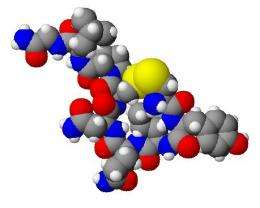Researchers reveal mystery of how contractions in labor grow stronger

Scientists, for the first time, have identified a mechanism in the muscle cells of the uterus that could point to how contractions in childbirth grow stronger.
It is understood that the hormone oxytocin plays a significant role in stimulating contractions during labour, which helps to move a baby down the birth canal. It is not known, however, how these contractions increase and sustain their strength during hours of labour.
A team at Liverpool investigated how uterine contractions grow stronger when the human body's 'biological rules' dictates that contractions should grow weaker as the tightening muscle squeezes the blood vessels, reducing oxygen and blood flow.
Professor Susan Wray, from the University's Institute of Translational Medicine, explains: "Laboratory tests have shown us that even when the hormone, oxytocin, is interrupted, surprisingly the muscle carries on contracting, and can grow stronger.
"This tells us that oxytocin's role, although significant, is not the only thing contributing to how this vital muscle contracts during labour. These findings prompted us to ask the question - how does this powerful muscle carry on working against the odds?"
The team looked for clues in studies on heart muscle, where a phenomenon called hypoxic preconditioning can elicit cellular changes that can protect it from more serious drops in oxygen, which can be life-saving.
The team, which also including PhD student, Mohammed Alotaibi and post-doctoral researcher Sarah Arrowsmith, found that the uterus reacts to the repetitive lack of blood supply and oxygen, by triggering another, previously unknown, process in the muscle cells that the Liverpool researchers have called hypoxia-induced force increase (HIFI).
In the laboratory they found that routine contractions in sample uterine tissue, when experimentally subjected to repeated, transient dips in oxygen (hypoxia), responded by gradually increasing in strength. Once the HIFI mechanism had been triggered it was sustained for many hours, just as occurs in labour.
Professor Wray added: "This is an exciting discovery, not only for increasing our general understanding of how biological systems can respond to the stress of low oxygen but for opening up new research pathways into difficult labours.
"We now believe that this uterine trigger could be key to resolving issues of prolonged labour, as well as the increasing number of births that result in emergency caesarean."
The research is published in the journal Proceedings of the National Academy of Sciences (PNAS).
More information: Hypoxia-induced force increase (HIFI) is a novel mechanism underlying the strengthening of labor contractions, produced by hypoxic stresses, Mohammed Alotaibi, 9763–9768, DOI: 10.1073/pnas.1503497112











.jpg)





